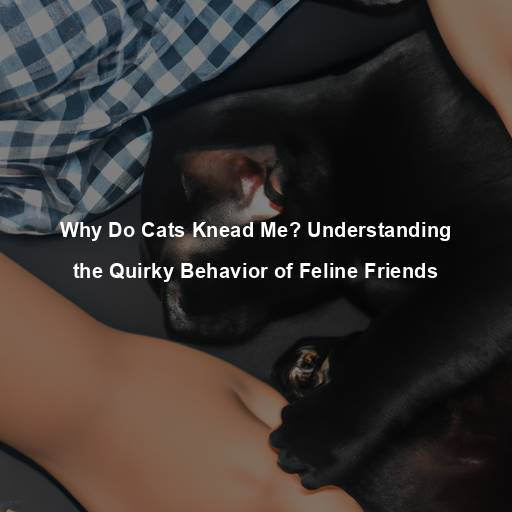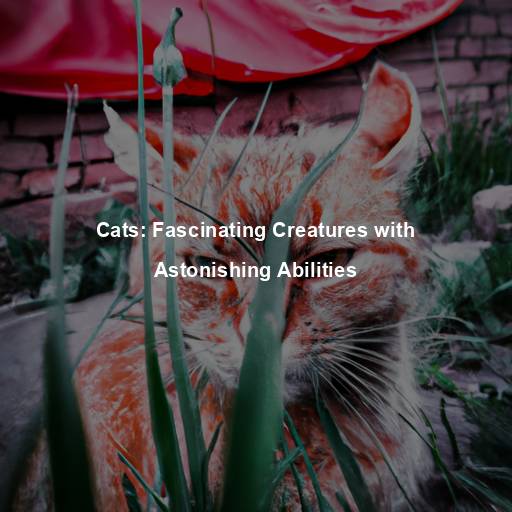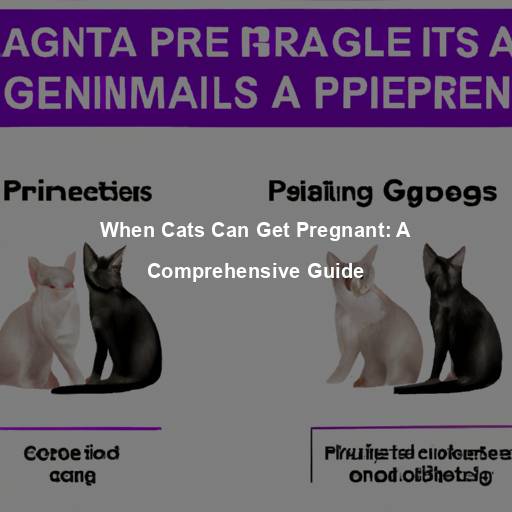Why Do Cats Knead on You? Unraveling the Endearing Behavior of Feline Friends
Last Updated on October 25, 2023 by Evan
Contents
- 1 Understanding the Fascinating Behavior of Cats
- 2 Appreciating the Whimsical Ways of Our Feline Friends
- 3 Embracing the Enigma of Cat Kneading
- 4 Embrace the Quirks of Your Kneading Kitty
- 5 FAQs – Why Cats Knead on You
Understanding the Fascinating Behavior of Cats
Cats are mysterious creatures that often leave us wondering about their peculiar behaviors. One such behavior that has puzzled cat owners for generations is kneading. Often accompanied by a blissful purr, cats engage in rhythmic paw movements against soft surfaces or even on their human companions. So, why do cats knead on you?
The Instinctual Remnant Theory: Echoes of Kittenhood
A Comforting Reminder of Mother’s Love
Have you ever wondered why your feline friend kneads on soft surfaces? Well, here’s an eye-opening theory that sheds light on this curious behavior. It is believed that kneading stems from a cat’s earliest days, when they would rhythmically massage their mom’s belly to coax out every last drop of milk. This endearing habit persists into adulthood as a way for cats to relive the comforting moments with their nurturing caregiver.
A Nurturing Response to Stress or Anxiety
One fascinating theory about why cats knead suggests that it could be a way for them to self-soothe. This instinctual behavior, similar to a child holding onto a security blanket, allows cats to find comfort and ease their stress or anxiety. By rhythmically kneading on soft surfaces or even human laps, cats release endorphins that contribute to a state of relaxation and contentment. It’s truly remarkable how these little creatures have such intricate ways of taking care of themselves.
The Territory Marking Theory: Leaving Their Scent Behind
Claiming Their Territory
Cats are territorial creatures, and they have various ways of marking their domain. One school of thought suggests that kneading is a form of scent marking. Cats possess scent glands in their paw pads, and by kneading on different surfaces, they leave their unique scent behind. This allows them to mark their territory and communicate their presence to other cats.
A Sign of Ownership and Affection
Furthermore, kneading may also be a way for cats to establish ownership and show affection towards their human companions. By kneading on their favorite person, cats are instinctively claiming them as part of their territory and displaying their affectionate bond.
The Comfort and Contentment Theory: Paws of Pleasure
Reliving a Sense of Comfort
There is an aura of mystique surrounding cats and their seemingly innate ability to find solace in the most luxurious and cushiony of nooks. It is said that when these graceful creatures knead, they transport themselves back to a time when their ancestors roamed the wilderness, delicately crafting cozy nests and secure bedding. The rhythmic motion against a velvety surface beckons a sense of tranquility and satisfaction in cats, freeing their minds to wander and their bodies to relax.
A Vestigial Reflex
Discover the feline mystery: the enchanting ritual of kneading. Unveiled by experts, its origins bewilder even the most astute minds. A vestige from eons past, when mighty cats ruled the wild, kneading was an essential art of transforming their slumber space into a sanctuary. Though domestication has shifted the landscape, this enigmatic instinct endures within our furry friends, a captivating reminder of their untamed past.
The Attention-Seeking Theory: Feline Flattery
Seeking Your Undivided Attention
Cats are known for their clever tactics to capture their human’s attention. Kneading can be seen as a way for them to elicit a response, whether it be a gentle stroke or a soothing voice. By kneading on you, your feline friend may be attempting to communicate their desire for interaction and affection. It’s their way of saying, “Hey, I’m here!
Associating Kneading with Positive Reinforcement
Over time, cats learn that kneading often results in receiving attention or rewards from their human companions. If your response to kneading is positive, such as offering affection or treats, cats may begin to associate this behavior with a pleasurable outcome. Consequently, they are more likely to continue kneading as a means of getting your attention.
Appreciating the Whimsical Ways of Our Feline Friends
Understanding the reasons behind why cats knead can deepen our connection with these beloved companions. Whether it’s an instinctual habit rooted in their kittenhood, a way to mark their territory, a means of seeking comfort, or a clever strategy to win our attention, kneading is a multifaceted behavior that reflects the complexity and individuality of our feline friends.
Let’s delve into the captivating universe of feline behavior, where our enigmatic and charismatic furballs never cease to amaze us with their curious and idiosyncratic ways. As devoted cat parents, it is our duty to honor these mercurial gestures and create a haven where our four-legged friends can freely express their innate nature. So, next time your kitty gently kneads on you with those velvet paws, take a moment to revel in the enchantment and let it serve as a testament to the unbreakable bond that binds you together. Because, it is through these small acts of feline affection that our lives are imbued with unparalleled richness and boundless joy.
The Genetic Predisposition Theory: Inherited Instincts
An Inherited Behavior from Wild Ancestors
Some experts propose that kneading is a behavior inherited from cats’ wild ancestors. In the wild, wildcats and other felid species would knead grass, leaves, or dirt to create a comfortable nesting spot. This behavior allowed them to flatten the surface and remove any potential threats, ensuring a safe and cozy resting place. Over generations, domestic cats may have retained this instinctual behavior, even though the need for it may no longer exist in our homes.
An Evolutionary Advantage
Throughout the course of evolution, the fascinating act of kneading has emerged as one of the perplexing traits of our feline friends. This peculiar behavior, believed to have bestowed cats with distinct advantages, unveils a wondrous insight into their innate instincts. With each rhythmic and purposeful motion, cats effortlessly mold their environment to cater to their undisclosed needs. From preparing a cozy haven for their delicate offspring to subtly communicating ownership of a territory, kneading persists as a captivating remnant of their untamed lineage, even if its practical significance might have diminished in our modern domestic dwellings.
The Sensory Stimulation Theory: Exploring the World Through Paws
Heightened Sensory Experience
Felines are remarkably attuned to their surroundings, with their paws serving as a gateway to the sensory wonders of the world. The fascinating phenomenon of kneading offers a profound sensory journey for our beloved cats. Their paw pads, buzzing with nerve endings, embark on a thrilling expedition of tactile stimulation. As they immerse themselves in this intriguing behavior, cats unlock a heightened understanding of diverse textures and surfaces, delving deeper into the enigmatic realms of touch.
A Kinesthetic Expression
Kneading, that rhythmic and perplexing action cats indulge in, holds deeper meaning beyond its surface charm. Much like how humans sway to a beat or perform art to convey emotions, cats employ kneading as a kinesthetic expression of their feline selves. This burst of energy unleashed through their paws could signify an outlet for pent-up exuberance, an external manifestation of sheer joy, or perhaps a coping mechanism to pacify unsettling restlessness. The enigmatic nature of this behavior continues to captivate our minds, unraveling the intricate world of our feline companions.
The Social Bonding Theory: Strengthening the Human-Feline Connection
Reinforcing the Bond with Their Human
It’s no secret that cats have a reputation for being fiercely independent creatures, but what many people don’t realize is that they also have the capability to develop profound connections with their human counterparts. One intriguing behavior that showcases this bond is when cats knead on their owners. In this perplexing display, cats exhibit a sense of relaxation and contentment, often coupled with a gentle purr and an earnest desire for physical closeness. Through the act of kneading, not only do felines indulge in the physical comfort provided by their human’s lap or chest, but they also partake in a shared moment of intimacy, solidifying the unbreakable connection that exists between them.
A Request for Affection
Have you ever wondered why cats sometimes knead on their human companions? Well, here’s a fascinating insight for you: it turns out that when they engage in this peculiar behavior, they are actually seeking affection. Yes, that’s right! By gently pressing their paws into your lap or chest, they are cleverly signaling their desire for attention, petting, or even a cozy cuddle session.
The Hormonal Influence Theory: A Chemical Communication
Scent-Marking and Communication
There’s more to your feline friend’s kneading habit than meets the eye. Cats are masters of communication, and one way they express themselves is through scent. Ever wonder why your cat loves to knead you? Well, it turns out, those soft paws contain scent glands that allow them to leave their unique mark on you, asserting their ownership and creating a bond that transcends words.
Hormonal Influence and Mating Behaviors
It’s no secret that cats can exhibit some unique and sometimes perplexing behaviors. Among these is the act of kneading, which can leave many cat owners scratching their heads in confusion. Interestingly, hormonal factors may play a role in triggering this behavior, especially in unneutered male cats who see it as part of their courtship repertoire. Alongside kneading, cats might engage in other intriguing mating behaviors like vocalizations, urine marking, or rubbing against objects.
Embracing the Enigma of Cat Kneading
Delving into the enigma of why our feline companions knead, we uncover an intricate tapestry of motives and symbolism. This mesmerizing gesture reveals itself as a tapestry of significance. It’s a nostalgic connection to their formative years, a territorial declaration, an uncomplicated quest for solace and satisfaction, a cunning ploy to capture your undivided focus, an experiential delight, a conduit for social cohesion, and even a subtle chemistry-based communication tactic. Kneading, in all its multifaceted glory, unveils the captivating complexity and individuality of our beloved cats.
As cat owners, we are often left baffled by the peculiar phenomenon of our furry friends kneading. While some experts claim it to be an instinctual behavior harkening back to their kittenhood, others believe it could be a form of communication or even an expression of contentment. The truth, however, remains elusive, leaving us to marvel at the enigmatic motivations behind this endearing action. So, rather than seeking concrete answers, let us revel in the mystery and appreciate the charm that our feline companions bring to our lives.
The Paw Massage Theory: A Relic of Nursing Behavior
A Nurturing Gesture
One theory suggests that kneading is a behavior reminiscent of a cat’s nursing instinct. When kittens nurse, they knead their mother’s mammary glands to stimulate milk flow. This gentle motion provides a comforting and nurturing experience for both the kitten and the mother. As adult cats knead on soft surfaces or even on their human companions, it may be a way for them to relive the comforting sensation of nursing and a sign of their contentment and trust.
Associations with Positive Experiences
The act of kneading may also be associated with positive memories and experiences for cats. The tactile sensation of kneading on a soft surface, combined with the nurturing memories of nursing, can create a sense of relaxation and pleasure. Over time, cats may learn to associate kneading with feelings of comfort, safety, and contentment, leading them to engage in the behavior whenever they seek these positive sensations.
The Stretching and Exercise Theory: Keeping Limber and Active
Maintaining Flexibility and Muscle Tone
Another perspective suggests that kneading serves a practical purpose for cats by helping them stretch and exercise their muscles. When cats knead, they engage multiple muscle groups in their paws, legs, and shoulders, promoting flexibility and maintaining muscle tone. It can be seen as a form of low-impact exercise that keeps their limbs limber and helps prevent stiffness or muscle atrophy.
Marking Territory Through Movement
Have you ever wondered why cats knead? It turns out that this adorable behavior serves a deeper purpose than just comfort. When cats knead, they are actually marking their territory through movement, leaving behind a unique combination of visual and olfactory cues that proclaim their presence to other animals. This non-aggressive form of territorial communication allows cats to assert their ownership over a particular space and establish boundaries.
The Comfort-Seeking Theory: Creating a Cozy Nest
Nostalgia for Safe Spaces
There’s just something about cats and their uncanny ability to seek out the coziest nooks and crannies for their much-deserved catnaps. But have you ever wondered about their peculiar habit of kneading? Well, it turns out that this instinctual behavior may actually have roots in their wild feline ancestry. As they gently paw and knead at soft surfaces, it’s as if they’re sculpting the perfect nesting spot, tailor-made to fit their unique body contours.
Creating a Familiar Scent
Aside from providing physical comfort, kneading also serves a fascinating purpose related to scent. Cats possess scent glands in their paw pads, which they can leave behind while kneading on various surfaces or individuals. This intriguing behavior aids them in establishing familiarity, a sense of ownership, and creates a soothing environment by enveloping themselves in their own distinctive scent.
Understanding Individual Differences in Kneading Behavior
Variations in Kneading Styles
Cats are truly enigmatic creatures, and kneading is just one of the many mysterious behaviors that add to their allure. Each cat possesses its own distinct kneading style, ranging from forceful paws to delicate touches. This fascinating ritual can convey a multitude of emotions, influenced by a feline’s personality, age, gender, and even their current mood or level of tranquility. By carefully observing and deciphering your cat’s intricate kneading patterns, you may uncover hidden insights into their personal preferences and emotional well-being.
Respect and Communication
As responsible pet owners, it is crucial to respect a cat’s boundaries during kneading. While it is generally a harmless and enjoyable behavior, some cats may become overly enthusiastic or exhibit kneading behaviors that cause discomfort. If your cat’s kneading becomes too intense or painful, redirect their attention to a suitable alternative, such as a soft blanket or toy. Maintaining open lines of communication and understanding your cat’s needs and preferences will foster a stronger bond and ensure a positive experience for both you and your feline companion.
Embrace the Quirks of Your Kneading Kitty
The enchanting and delightful phenomenon of cat kneading never ceases to amaze and perplex us. Although each furry feline may have their own enigmatic motives, the heartfelt themes of comfort, nurturing, exercise, and communication persist throughout. By embracing and cherishing this peculiar behavior, we not only gain valuable insights into our beloved pets, but we also forge deeper connections with them. So, the next time your cat begins their rhythmic kneading routine, allow yourself to be captivated by the sheer joy and adoration they bestow upon you, reminding yourself that you hold a special place in their whimsical world of kneading ecstasy.
FAQs – Why Cats Knead on You
What is kneading and why do cats do it?
It’s no secret that cats have some quirky behaviors, but one that often leaves their owners scratching their heads is kneading. You know, that peculiar paw-pushing motion they do that can feel like a mini massage or a soft torture session? Well, turns out, this seemingly perplexing behavior actually has a colorful array of reasons behind it. From showcasing their love and affection to staking their claim on your lap or the nearest cozy blanket, cats just can’t resist engaging in this burst of feline bliss. And hey, with its added benefits of muscle stretching and promoting relaxation, maybe we could all use a little kneading in our lives.
Why do cats knead specifically on our bodies?
When cats knead on your body, it is a display of trust, comfort, and affection towards you. By kneading on you, they are claiming you as their territory and leaving their scent behind through the sweat glands in their paws. Kneading on your body is a way for cats to show that they feel safe and secure in your presence. It is also reminiscent of the behavior they exhibited as kittens when nursing, associating the kneading motion with feelings of warmth and contentment.
Does it hurt when a cat kneads on you?
While most cat owners find kneading from their feline companions to be a delightful display of affection, there are instances where this seemingly innocent behavior can take a prickly turn. In certain cases, those unrestrained claws can cause a sting or irritation, leaving you perplexed on how to proceed. Don’t fret! To ease the discomfort, consider introducing a cozy barrier like a snug blanket or plush towel between your precious pet’s paws and your delicate skin. Simultaneously, regular nail maintenance can play a pivotal role in minimizing any potential discomfort that arises from their enthusiastic kneading sessions. Let’s keep the bursts of love from your furry friend as pain-free as possible!
Is kneading a sign of happiness in cats?
When it comes to feline behavior, the mystifying art of kneading unveils a fascinating tale of bliss and tranquility. In the realm of contentment, cats sashay into a state of pure relaxation, unleashing their kneading prowess upon our unsuspecting laps. This enigmatic act serves as a conduit for stress-eradication, a cunning escape from tension that echoes their profound satisfaction with their surroundings and their unspoken connection with their biped counterparts. Nevertheless, let us unravel the enigma that is the feline psyche, for the absence of kneading does not belie discontent nor diminish their boundless affection.
Can I encourage or discourage my cat from kneading?
You cannot force a cat to knead or prevent them from doing so entirely. Kneading is an instinctual behavior deeply rooted in feline anatomy and behavior. However, you can provide appropriate alternatives for kneading, such as providing them with a soft blanket or a plush toy, which they can knead to their heart’s content. If your cat’s kneading becomes bothersome, you can gently redirect their focus to the alternative surface and provide positive reinforcement when they utilize it instead. It’s essential to remember that kneading is a natural cat behavior, and discouraging it entirely may disrupt their sense of comfort and security.







